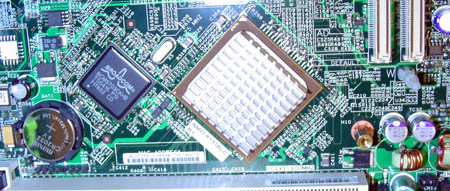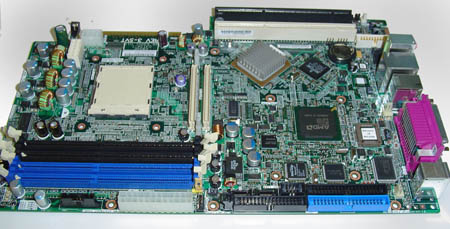Sun's W2100z Dual Opteron Workstation
by Kristopher Kubicki on October 27, 2004 12:05 AM EST- Posted in
- Systems
Components
The simplest way to detail the Sun w2100z is to just open it up and look at what Sun put under the hood. Our side panel on the workstation actually provides us with detailed knowledge of how the system works. You can see the side panel reference below.The core of the Sun w2100z is its K85AE motherboard. The K85AE is wildly different from anything to which we are accustomed, even when looking at server motherboards. Sun's modular approach to component design makes it a lot easier to upgrade (providing you use Sun components) and in turn, gives Sun customers a uniform base of components to pick and choose. Our particular w2100z came with all of the options, so we can detail them here.
| Sun K85AE Specifications | |
| CPU Type | (2) AMD Socket 940* |
| Memory Banks | (4) 1GB PC-3200 ECC DDR* |
| HyperTransport Tunnel | AMD 8111 |
| AGP Tunnel | None |
| PCI Tunnel | AMD 8131 |
| SATA | Silicon Image Sil3512 |
| PCI Slots | (1) 133MHz PCI-X (1) 100MHz PCI-X |
| SATA Ports | (2) U150 |
| PATA | (2) ATA100 |
| Audio | Realtek ALC655 AC'97 |
| Network | Broadcom BCM5703 Gigabit Ethernet |
| Firewire Ports | (2) |
| USB 2.0 Ports | (2) |
You'll notice the star next to the CPU type and Memory banks. The K85AE is a single CPU motherboard with a "CPU mezzanine" - two risers (one for power, one for IO) rise up through the center of the motherboard to provide four additional DDR banks and one additional CPU slot. Sun only needs to produce a single motherboard design and significant space inside the motherboard is saved. The idea of a CPU mezzanine is not new - particularly for Sun - but seeing such technology up close is always exciting. Below, you can see the CPU mezzanine removed from the system (a high resolution reverse side image can be found here.
There isn't anything too interesting about the mezzanine itself. Sun somewhat exploits the design of Opteron by placing the memory on the mezzanine with the CPU. Remember, all Athlon 64 and Opteron processors have their own memory controllers - each processor has its own memory bank. Technically, the primary Opteron on the motherboard can utilize the memory on the mezzanine via the HTCN bridge, although there is a performance hit by doing so.
The CPU mezzanine sits directly on top of the AMD 8111 HyperTransport hub and the first AMD 8131 PCI-X tunnel. Removing the mezzanine also reveals the Broadcom gigabit Ethernet controller, BIOS and SATA controller. You can read more about the SI controller here, and more about the Broadcom controller here. Both devices have fairly strong Linux support as we will see later in our analysis. The fact that our SATA controller only supports two drives is not of huge significance, since the chassis can only hold two drives anyway. Below is an image of both controllers once the CPU mezzanine is removed. The AMD 8131 is covered by an aluminum heatsink.
The entire board layout without the extender card can be seen below (those interested in a high resolution reverse side image can get that here:
The K85AE mainboard is far from legacy free. When we first unpackaged the workstation, we were surprised to not see any PS/2 interfaces (the included keyboard and mouse are USB). Under closer inspection, we noticed that PS/2 connectors did in fact exist, but they were covered by the EMI shield from the case. The motherboard houses two serial connectors and one parallel connector as well.
Also note the 133MHz PCI-X connector (black). The majority of peripheral components on the mainboard are very basic including the Realtek AC'97 audio controller. Sun seems very shy on USB, including only five devices (two of which must be used for the keyboard and mouse unless the PS/2 ports are revealed).














47 Comments
View All Comments
najames - Friday, October 29, 2004 - link
I use a Sunfire V440 daily at work. It is a 4cpu large entry level server seen here.http://store.sun.com/CMTemplate/CEServlet?process=...
I program daily on mainframe, Solaris, and PC. Benchmark programs I wrote took 38cpu seconds on the mainframe, 38cpu seconds on my PIII pc, 17cpu seconds on Solaris. Four programs submitted at once on the the mainframe took 38cpu seconds but wall time was hours, the PC choked, the Solaris server still did them in 17cpu seconds each in about the same wall time. The Solaris server didn't slow down, period. We have combined large programs that individualy would sometimes crash on the mainframe and the Solaris Unix server burns through them even with temp space going over 12gigs druing processing.
If the Sun Opteron server is anything like my little Sunny, they sould do very well.
Reflex - Friday, October 29, 2004 - link
*laff* Something tells me thats not the case.My curiosity is just that since these are obviously relabels, I am wondering who the original manufacturer is as the hardware is excellent and it might be nice to be able to acquire these for white box systems.
morespace - Friday, October 29, 2004 - link
Egad. You're absolutely correct. I didn't notice the daughterboard arrangement in that picture at first. It looks flat. But looking more closely at the placement of chips and capacitors on those motherboards, it's more than a family resemblance - they appear identical!I sense a conspiracy.
The hard drive enclosures appear different for what it's worth. Who makes these really? Apple?
Reflex - Friday, October 29, 2004 - link
I take that back, that is the same as the one I have on my bench, however their cabling is a bit more messy.Look closely. Anandtech did not show a straight out picture from the same angle, but thats the same motherboard in more or less the same chassis with a few modifications. The CPU, chipset, Adaptec chip, PCI and AGP slots are all in the same places on that board, both use the daughtercard method for the CPU, etc.
Thats why I am asking who actually makes that board and case, someone is preconfiguring the servers and Sun/IBM are labelling and reselling them.
Reflex - Friday, October 29, 2004 - link
That is not the same Intellistation that I have on my lab bench. I'll look up the model number when I go back in, but seeing as its friday night that won't be till monday.morespace - Friday, October 29, 2004 - link
Reflex, what are you on about? Here's a picture of the insides of an IBM Intellistation A Pro:http://www.digitalcad.com/articles/viewarticle.jsp...
Tell me, how does this look like a w2100z?
Nsofang - Friday, October 29, 2004 - link
Zealots on both sides always mess up any discussion. This is a review about the Sun WORKSTATION, yet punks bring in supercomputer arguments. WTF!! is wrong with you guys! If anything bring in arguments/discussions about comparable hardware G5's/Itaniums/NEC/SGI, something that adds to the discussion, not subtract.slashbinslashbash - Thursday, October 28, 2004 - link
#33: You're right, for "general purpose computing" FLOPS is a pretty bad measure, but you've just changed your argument. For "high-end workstations" (what this argument is supposedly about) FLOPS can be *very* relevant, depending on the application.#34: I meant "nothing special" in terms of how supercomputing clusters are normally hooked up. Just a few years ago, Gigabit Ethernet cards cost $200, and their most prominent application was in supercomputing clusters.
Reflex - Thursday, October 28, 2004 - link
#37: Yeah, I know, I was in a mood yesterday or I wouldn't have let him get me into it. ;)And you just made the point I was trying to make. While price can be an issue in the corporate space, its only the deciding factor when all other factors are equal. I was not even trying to get into a Mac vs. PC debate, this really has nothing to do with Mac's.
I do want to know who is building these workstations though, because its not Sun despite the label.
bob661 - Thursday, October 28, 2004 - link
Reflex,He's trying to pull you off the subject. Supercomputers are irrelevant in this discussion. The thread is about workstations. Sun markets workstations. Apple does not. I know our company doesn't care about a couple hundred or even a couple thousand dollar difference if the service is impeccable and the workstation performs the task without headaches.